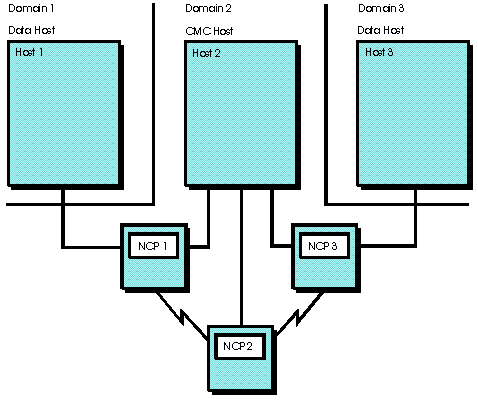 z/OS Communications Server: SNA Network Implementation Guide
z/OS Communications Server: SNA Network Implementation Guide
 z/OS Communications Server: SNA Network Implementation Guide
z/OS Communications Server: SNA Network Implementation Guide
|
Previous topic |
Next topic |
Contents |
Contact z/OS |
Library |
PDF
Sharing NCP peripheral nodes (CMC configurations) z/OS Communications Server: SNA Network Implementation Guide SC27-3672-01 |
|
|
When you plan to share NCP resources:
Figure 1 shows a possible CMC. In this figure, NCP1 is channel-attached to HOST1, but it is in HOST2 domain. NCP1 is a channel-attached cross-domain NCP with respect to HOST1. The same relationship applies between NCP3 and HOST3. All three NCPs are controlled by HOST2, the CMC host, which means HOST1 and HOST3 can contact their channel-attached NCPs and communicate with resources attached to them without activating those NCPs, which is normally referred to as a data host connection. CMC HOST2 is responsible for activating all three NCPs. You must define the channel connection between the data hosts and NCPs in a channel-attachment major node. However, the VTAMs in the data hosts do not require the NCP load module, the NCP resource resolution table (RRT), or any NCP major node definitions in VTAMLST. All network problems are handled by HOST2. HOST1 and HOST3 (designated as data hosts) do not own any of the network resources. All LU-LU sessions to remote network resources are cross-domain sessions. The channel connection between HOST2 and NCP1 is defined to HOST2 in a channel-attachment major node. The normal operating activation procedure for a CMC configuration consists of the following steps:
If CMC HOST2 fails and must be backed up by data HOST1, HOST1 activates NCP1. In this case, HOST1 needs a copy of the NCP source and RRT. Activating the NCP establishes an SSCP-PU session between HOST1 and NCP1; HOST1 becomes the new CMC host. HOST3 can provide backup for HOST2 in much the same way. However, for either data host to back up the CMC, VTAM® must be capable of accessing the NCP major node definitions in VTAMLST and a copy of the NCP RRT. If either data host also needs to load or dump the NCPs in backup situations, VTAM needs access to the NCP load modules, service switching point (SSP), and dump data sets. Figure 1. Example of communication
management configuration
 For further information about CMC configurations, see:
Note: The NCP must be loaded and active if VTAM is to contact the NCP but not establish
an SSCP-PU session with it.
If the NCP is deactivated with the VARY INACT command at the CMC and the channel-attached major node is active, sessions using the channel path to the data host continue uninterrupted. 


|
 Copyright IBM Corporation 1990, 2014 Copyright IBM Corporation 1990, 2014 |